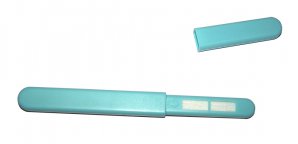Neutrons shed light on how to make pregnancy tests more sensitive and cheaper
Neutron reflectometry experiments at the ILL and ISIS
02/09/2014

Pregnancy test. © Ceridwen, from Wikimedia Commons.
A team of scientists found how to make pregnancy tests more sensitive and cheaper. Thanks to neutrons, they could investigate the interaction between antibody and antigens and the importance of a blocking protein, present in home pregnancy tests. They observed that to achieve the required conditions for an effective test, it is necessary to control the structural orientations of the antibodies immobilised. They also found that to achieve an optimal performance there is no advantage in increasing antibody quantity above a certain level. Thus, neutron studies can help not only control the quality but also reduce cost considerably because antibodies are very expensive.
Pregnancy tests are a well-known example of immunoassays. They use the specific binding of an antibody to measure the concentration of antigens in a test solution, as for instance urine in pregnancy tests. For the tests, the antibodies need to be immobilised onto a solid substrate, which makes them less efficient as it reduces the chances of antigens binding to antibodies. In the pursuit of more sensitive tests, the team investigated the behaviour of immobilised antibodies by conducting neutron reflectometry (NR) experiments at the ISIS neutron source in the UK and the Institute Laue-Langevin (ILL) in France. NR is one of the few techniques that can accurately determine the surface coverage, density and thickness of adsorbed antibodies.
The study revealed that it is important to have a blocking protein (in this case, human serum albumin, HSA, was used) as it avoids false positives and therefore makes the tests more consistent and reliable. Thanks to the NMI3-I’s Joint Research Activity on Deuteration , the group could use deuterated HSA which made it possible to better visualise how blocking proteins behaved.
This work sheds light on the processes behind immunoassays, and pregnancy tests in particular. Immunoassay systems are widely used in clinical tests and in the detection of environmental contaminants.
Original publication
B. J. Cowsill, X. Zhao, T. A. Waigh, S. Eapen, R. Davies, V. Laux , M. Haertlein , V. Trevor Forsyth , and J. R. Lu, Interfacial structure of immobilized antibodies and perdeuterated HSA in model pregnancy tests measured with neutron reflectivity, Langmuir, 2014, 30 (20), pp 5880–5887
Relevant links

This work benefited from the NMI3-I JRA on Deuteration.
NMI3 thanks Jian R. Lu for reviewing this article.
